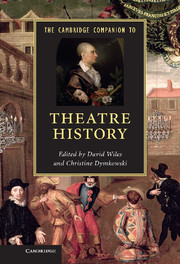Book contents
- Frontmatter
- Contents
- Illustrations
- Notes on Contributors
- Acknowledgements
- Part I Why?
- Part II When?
- Part III Where?
- Part IV What?
- Part V How?
- 15 The nature of historical evidence: a case study
- 16 The visual record: the case of Hamlet
- 17 Museums, archives and collecting
- 18 Re: Enactment
- 19 The internet: history 2.0?
- Index
- References
18 - Re: Enactment
from Part V - How?
Published online by Cambridge University Press: 05 February 2013
- Frontmatter
- Contents
- Illustrations
- Notes on Contributors
- Acknowledgements
- Part I Why?
- Part II When?
- Part III Where?
- Part IV What?
- Part V How?
- 15 The nature of historical evidence: a case study
- 16 The visual record: the case of Hamlet
- 17 Museums, archives and collecting
- 18 Re: Enactment
- 19 The internet: history 2.0?
- Index
- References
Summary
What are we to do about reenactment? . . . One easy answer is to say of reenactment as of sexually transmitted disease, that there is a lot more of it about nowadays.
Following the lead in the next chapter, a cursory glance at Wikipedia delivers a list of over 178 historical re-enactment groups of which at least 48 organisations are identified as UK-based, over 40 are in the USA, with others offering cross-national membership in groups as far afield as Romania and Taiwan. Their activities chiefly offer involvement in battles and military events, dating from as early as 284 ce to the South African border wars in 1989. The long-established practice of reconstructing and re-enacting military engagements is far from the only area upon which scholarly interest around re-enactment has begun to focus. The desire to ‘know’ about one’s own past, the individualised genealogical quest for a personal family history, has elided with a public desire for a shared cultural memory, both coming together to satisfy what cultural historians recognise as a ‘yearning to experience history somatically and emotionally – to know what it felt like’. British television companies have embraced this appetite for popular histories with re-enactment programmes on life in Edwardian country houses, Victorian pharmacies, Georgian town houses and village high streets down the ages. These places are all brought to life by teams of historians, behind and in front of the camera, aided by willing (re-en)actors, offering a stream of entertainment that is educational in remit and, crucially, economically successful. Worldwide spin-offs promise participants and their audiences a ‘just-as-it-would-have-been’ experience, which often, as Anja Schwartz observes of the Australian Outback House (Australian Broadcast Corporation, 2005), ‘mixes traditions of re-enacting historical events in period dress with documentary television and Big Brother’s “fly-on-the-wall” format that portrays participants subjected to a group endurance test’. For those wanting more than a couch-bound experience, Google offers a calendar of re-enactment events and a portal to a tempting array of retail outlets for chainmail, medieval shoes, and battle-ready helmets, with specialists like Seraphima Needlework offering to provide tailor-made ‘bespoke garments’ for male and female re-enactors who ‘“play” in the Napoleonic period’. It is this crossover between play and performance, this slippage between the real and the imagined, that provokes the academic unease expressed in my epigraph. That half-joking analogy between these activities and the diseases of sexual promiscuity goes to the heart of the matter: we are deeply alarmed by the fetishistic attention to, and visceral excitement of, the embodied engagement with the past.
- Type
- Chapter
- Information
- The Cambridge Companion to Theatre History , pp. 281 - 298Publisher: Cambridge University PressPrint publication year: 2012
References
- 1
- Cited by

